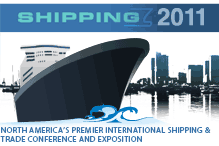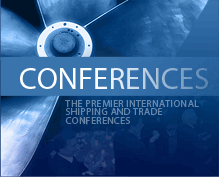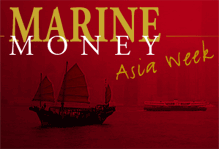
Managing Expectations
By their nature all public companies are focused on their shareholders, but General Maritime’s behavior, at times, seems compulsive. And that is a good thing. Back in 2007, the company recapitalized itself, adding debt so it could pay out a special dividend of $11.19 (adjusted) per share, when there were no opportunities that met the company’s investment criteria. To management, it was appropriate to return the capital to the shareholder.
Today the world is different. The tanker market has weakened straining cash flows on one hand but offering up investment opportunities on the other. In response, management has changed the dividend policy to pay out a fixed annual dividend of $0.50 per share, which is a visible and consistent payout supported by Genmar’s current contracted revenue stream. Jeff Pribor, Chief Financial Officer, commented, “… The adoption of our new dividend target is the result of our Board’s voluntary reassessment of our dividend policy based on current market conditions. We believe it will enable General Maritime to continue its tradition of distributing cash to shareholders during a challenging market environment. By implementing a more conservative payout ratio, we believe we have also strengthened our financial flexibility to enter into future value creating transactions and take advantage of strategic growth opportunities…”
Here, too, credibility goes a long way.
Navios Uses Its Credit Again
Navios Maritime Holdings took delivery of three Capesize bulkcarriers in June and July from South Korean shipyards. Two of the vessels were financed with 10-year term facility for $120.0 million with a margin at 190 bps. The third vessel is financed with a 10-year term facility for $60.0 million with margin at 225 bps.
In addition, the company issued a $20.0 million unsecured bond due 2012 in partial payment of the purchase price due. The bond is structurally subordinated to the existing $300.0 million Senior Note outstanding and those other obligations that are guaranteed by Navios Holdings’ subsidiaries. Interest will accrue on the principal amount at the rate of 6% per annum and will be payable at maturity in July 2012 without compounding. The bonds may be prepaid by at any time without prepayment penalty.
While others try to defer or cancel newbuildings, Navios continues to meet its obligations with a twist. The company’s reputation, credibility and insured term employment enable it to obtain seller’s credit with “soft” payment terms making the transaction workable in today’s environment and a win-win for both parties.
More Equity On the Way?
Speaking of the markets, one, in particular, has done well lately, which has certainly cheered both investors and investment bankers. Yes, the stock market, as measured by the DJIA, has increased about 40% from its low of 6627 on March 6th to its close on Thursday of 9256. While we do not pretend to be market seers, the rise is as mysterious to us as how quickly the stimulus appears to have worked in China. Rather than try and understand it, we intend to sit back and enjoy it.
With the stock market at these levels, there should continue to be more follow-on offerings as soon as everyone returns from vacation. With the bank market somnolent, the equity markets appear to have a monopoly on capital raising. While we remain unflagging in our belief in the return of high yield, raising equity to de-lever and repair balance sheets seems like a useful exercise in the interim.
What Do They Know?
Despite positive signs of economic growth emanating out of China and deliveries still slipping, two of the most market savvy owners engaged in what we considered some conservative chartering activity last week.
During its second quarter earnings announcement, Pankaj Khanna announced that DryShips had fixed 12 Panamax bulkers for $16,000 per day for two years in a strategic move designed to secure its cash flows in any given environment, particularly in light of recent market volatility. The logic is impeccable when you consider that $1.1 billion in revenue has been locked in for the next 2 1/2 years with a resulting fleet coverage as follows:
Continue Reading
What Happens When the Cash Runs Out?
CONSIDERATIONS FOR CREDITORS & SHIPOWNERS FACED WITH INSOLVENCY1
By Nick Hanna, Watson, Farley & Williams
It is happening all around us: Companies that own ships are staring at poor balance sheets and wondering what to do. For some, they have to restructure their debt positions with their creditors or face the real prospect of insolvency.
The purpose of this article is to provide a general overview of the sometimes tricky path of restructuring and insolvency, bearing in mind the particular nuance about shipping companies, i.e. the vessels they own are themselves exposed to direct “attachment” by certain class of creditors (either by way of contractual security or through in rem actions), who might have little regard for the rules of insolvency.
The article focuses on the rights of creditors to financially stricken shipowners and critical considerations in seeking to obtain payment of creditors’ rights. On the flipside, the article provides some guidance on the rescue and winding up mechanisms available to crippling shipowners and the effect of such options on the pack of creditors with varying abilities to bite onto the assets of the company.
1 OPTIONS AVAILABLE TO CREDITORS
(i) Secured creditors
As one will learn from business experience, the lack of security when dealing with a company that subsequently heads into financial woes can effectively result in an unsecured creditor walking away empty handed. This is because a company is often bamboozled into liquidation by a snowball of a variety of claims: secured, unsecured, preferential, in personam, in rem etc. Secured creditors have the theoretical ability of reaching for their security and grabbing it from the company’s crumbling assets, leaving unsecured creditors at the bottom of the food chain to scrap for any remaining assets on an equal basis. In so far as the realization of the security falls below the claimed amount, such a shortfall will be deemed to be an unsecured credit (and in that respect, the creditor is deemed to be an unsecured creditor). This is particularly relevant in the shipping industry when vessels deemed as security by banks at the time of entering into financial arrangements are no longer as valuable in the market today.
In that regard, banks need to have one eye on the market value of their security whilst maintaining their ability to realise their security at the hint of insolvency to avoid the complications involved in the restructuring and winding-up proceedings, as described below.
Marine K&R an Above “Average” Marine Insurance
By Capt. Thomas Brown, Seacurus Limited
It would appear to the casual observer looking in on the marine insurance industry that confusion continues to reign over the way in which the marine insurance industry has reacted to the modern day threat of piracy and the ensuing cases of kidnap for ransom of ships and their crews off the Horn of Africa.
The sheer size of the international waters in which the attacks take place and the randomness of these attacks in the Gulf of Aden and Indian Ocean off Somalia have taken the industry by surprise. Ship-owners whose vessels transit these waters now face the real possibility of incurring large losses as a consequence of this illegal activity. However, unlike other marine emergency and casualty situations ship-owners may have faced in the past, it is by no means certain to whom they should turn when faced with a ransom demand for the release their vessel and crew.
Their traditional marine Hull, P&I and War underwriters all have legitimate reasons why NOT to get involved. None of the coverages offered by these traditional marine insurances have properly dealt with this unique set of circumstances that have conspired to give rise to the risks associated with this modern day threat of piracy.
In this article we will try to look behind the patchwork of traditional marine insurance coverage to see what is covered where and by whom and look at how the risks can be properly covered.
Lessee Warning
By Richard Greiner and David Chopping, Moore Stephens
Summary
The IASB has issued its preliminary views on accounting for leases, the first stage in a process intended to alter IAS 17.
As a discussion paper, this is a long way from a revised standard, but is nonetheless a good indicator of future developments.
Introduction
The discussion paper deals with leases only from the perspective of the lessee, and there is a deliberate decision to defer full consideration of lessor accounting, although one section of the discussion paper does deal with some of the issues that would need to be addressed in any consideration of lessor accounting.
The IASB provides various reasons why lease accounting is due for reconsideration, amongst which are:
• operating leases (per current definitions) give rise to assets (the right to use the leased item) and liabilities (the obligations to make payments) which are not currently reflected in financial statements;
• the accounting treatments of operating and finance leases are very different, yet in some cases the differences between leases subject to each regime are quite small; and
• partly as a result of the previous point, it is possible to structure a lease to achieve a certain accounting treatment and, in particular, to ensure that a lease is classified as an operating lease to ensure that the financing obligations are not recorded as a liability on the balance sheet.
The IASB has considered whether the scope of any future standard should change from that included in current standards, and has tentatively decided that it should not.
Search for the Silver Lining
By Rodricks Wong
The shipping funds established by state-run debt-clearing agency Korea Asset Management Corp (“KAMCO”) and Korea Development Bank (“KDB”) were thrust into the media limelight recently after reigniting concerns over the role of government backed funding in bailing out the industry.
In April 2009, the Korean government announced that it would contribute USD 800 million (1 trillion won) to a fund established together with financial institutions and private investors. The objective of the fund is to provide shipping companies with liquidity through the acquisition of up to 72 ships put forward by the owners. This measure is aimed at supporting the local shipping industry that has been severely affected by the global economic crisis. However, though government owned, the fund is being operated on a commercial basis. Industry watchers have previously cautioned that without any government aid, Korea will witness a chain of bankruptcies will emerge in its shipping sector. Already, Parkroad Corporation, C& Group, Samsun Logix, Daewoo Logistics and TPC Korea have filed for bankruptcy or receivership since the financial crisis.
KAMCO was restructured during the Asia financial crisis in 1997 to resolve the problem of non-performing loans in the financial institutions, and its key role has since been raising the money and managing its non-performing asset management funds. Apart from taxpayer’s money, KAMCO raises capital for its funds through bond issuances, loans and contributions from financial institutions. This time, it will be attempting to replicate its success in the shipping industry. During the 1997 Asian Financial Crisis, Korean shipping lines sold their ships at hefty discounts below the market prices which led to the loss of newbuilding orders and vessels from the existing fleet falling into the hands of foreign owners. It could also be argued that by initially targeting support at the owners, the Korean government is also trying to pre-empt the type of large-scale cancellations that could endanger its shipbuilding industry.
When One Becomes Two
By George Weltman
Introduction
For the Norwegian banking community, offshore and shipping have historically been inseparable and Marine Money, until this year, has consistently followed that truism. The world, however, changes. Our annual rankings universe continues to grow and now exceeds over 100 shipping companies. Within that group it was our belief that the offshore companies were no longer a good fit and were, in fact, getting short shrift being compared to the multitude of dry bulk and tanker companies. Moreover, the offshore industry, particularly supply and subsea, was assuming a larger portion of our conference content, particularly in Norway and Asia. It has, in our eyes, achieved a status where it should be analyzed as a standalone. So, for the first time, we present our annual rankings of the offshore supply industry.
Although one might quibble with our limited focus, we have attempted to stay true to our shipping roots by limiting ourselves more or less to the companies that supply and support the offshore industry. We have intentionally excluded drilling rigs, even though they are classed as vessels. Like the cruise industry, the underlying dynamics of the offshore drilling industry have nothing to do with shipping and the only thing the two have in common is that both have assets that float.
The universe of companies we are looking at is highly differentiated. While many are largely pure play, a significant portion is diversified, making comparisons difficult. Among the ancillary activities these companies engage in are shipbuilding and repair, brown and blue water shipping and drilling. There is even a conglomerate, which bottles soda, and owns both property and an airline. We have included them all, because despite their differences they are all major players in this segment and to exclude any makes the analysis less worthwhile.
Finally, the decision to create a separate ranking created an opportunity to examine the model itself. While generally we are strong proponents of the philosophy “if it ain’t broken don’t fix it,” we sought out Glenn Muller to help with certain technical aspects of the model which then evolved into a closer look at the methodology itself. Based upon our discussions, some fine-tuning was clearly warranted and, in fact, implemented. In converting local currency items on the balance sheets to dollars, we now use the average foreign exchange rate for the year. In addition, all metrics are now calculated on the basis of local currency. More information about our model is detailed in the following article, “The Rankings Methodology.”
Alternatives for Raising Equity in Today’s Market- Part I
By Ethan Ram, DVB Capital Markets LLC
The collapse of freight rates and asset values across most shipping sectors has put a premium on liquidity and access to capital. Today many publicly listed shipping companies are faced with depleted cash reserves, limited or no availability under debt lines, and, worse, debt covenant defaults, which threaten their viability as a going concern. Meantime, given the scarcity of debt, the better-capitalized companies that hope to take advantage of the market downturn are faced with having to fund a significant portion of their acquisitions with equity. For those companies that are able, tapping the public markets for equity regardless of whether to raise “survival capital” or dry powder has been made more challenging by the increase in volatility and the sharp decrease in company valuations.
In the current volatile stock market environment, the window for raising equity can be short. As a result, a successful offering may be dependent on the speed at which a deal can be brought to the market and priced. Speed can be enhanced if the issuer has an effective shelf registration on file with the SEC. After the shelf registration has been reviewed and declared effective by the SEC, the company is free to make continuous offerings of securities over the following three years without further SEC review. This is in sharp contrast to a traditional follow on offering, which requires SEC review of the prospectus, a process that can take three weeks or more. With a shelf in place, a company has at its disposal several alternative methods for raising capital that may mitigate pricing volatility. These include an At the Market offering, or “ATM”, an overnite offering, and a Wall Crossing, each of which are discussed below.







